 STREET TRUCKS STAFF
.
August 11, 2020
.
Department
STREET TRUCKS STAFF
.
August 11, 2020
.
Department

LIKE MOST OTHER PEOPLE IN THE TRUCK SCENE, JASON JONES HAD DREAMS OF BUILDING SOMETHING BIG THAT HE COULD DEBUT AT THE SEMA SHOW. However, Jason knew he didn’t want to create just another C-10 with an LS swap and air ride that could potentially get lost in the crowd. In order to leave his mark, he needed to build something that would not only be different but stylish as well. At the 2013 SEMA Show, Jason saw Snakebit, a ’56 F-100 built for charity. He knew that he couldn’t simply replicate the truck, but Snakebit was the catalyst that spurred him to create something different.
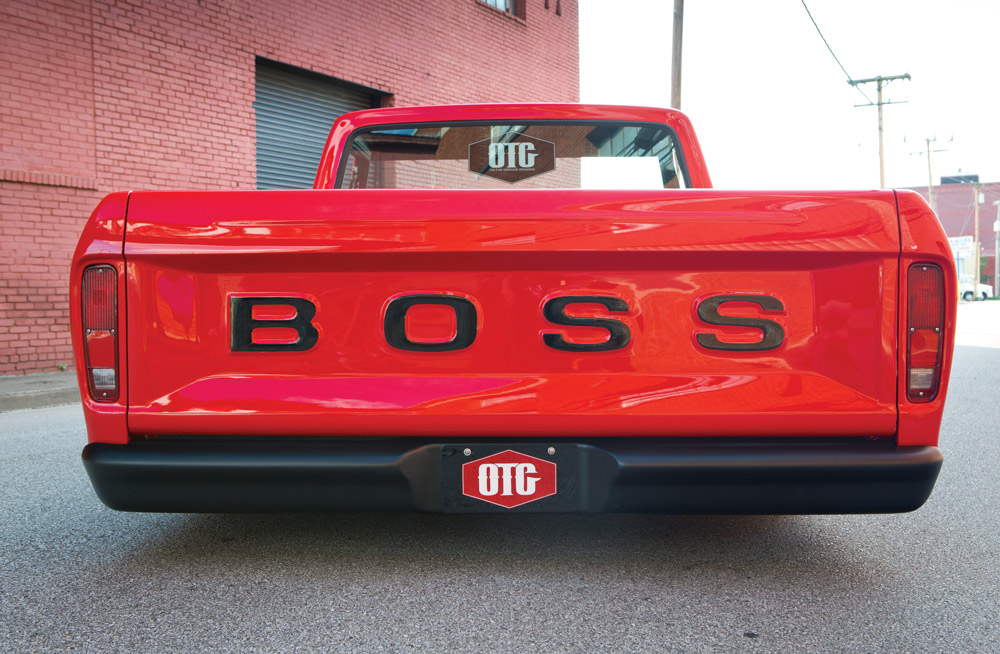
On the heels of the 2013 SEMA Show, Jason made his way to Detroit Autorama. While in the area, he figured he would visit the Henry Ford Museum in Dearborn. He stumbled upon the F-150 manufacturing plant there and gathered more inspiration. Jason came up with the idea of building a ’70s model F-100 and taking some Boss Ford styling cues to pay homage to the muscle car era. From there he found this ’73 F-100 farm truck that was still in running condition and snagged it for $2,500.
“THE TRUCK WAS PERFECT. IN THE LAST DECADE WE’VE SEEN A FEW SIXTH GENERATION (1973-79) FORD “DENTSIDE” F-100S LIKE THIS ONE BUILT TO TURN HEADS.”

The truck was perfect. In the last decade we’ve seen a few sixth generation (1973-79) Ford “Dentside” F-100s like this one get built to turn heads. The beauty of creating a new craze with a truck like this is that you lead people in a new direction they’ve never considered before. The only obstacle is the lack of aftermarket parts availability to modernize these classic trucks; however, if you build it (and they gain serious popularity), the parts will come.

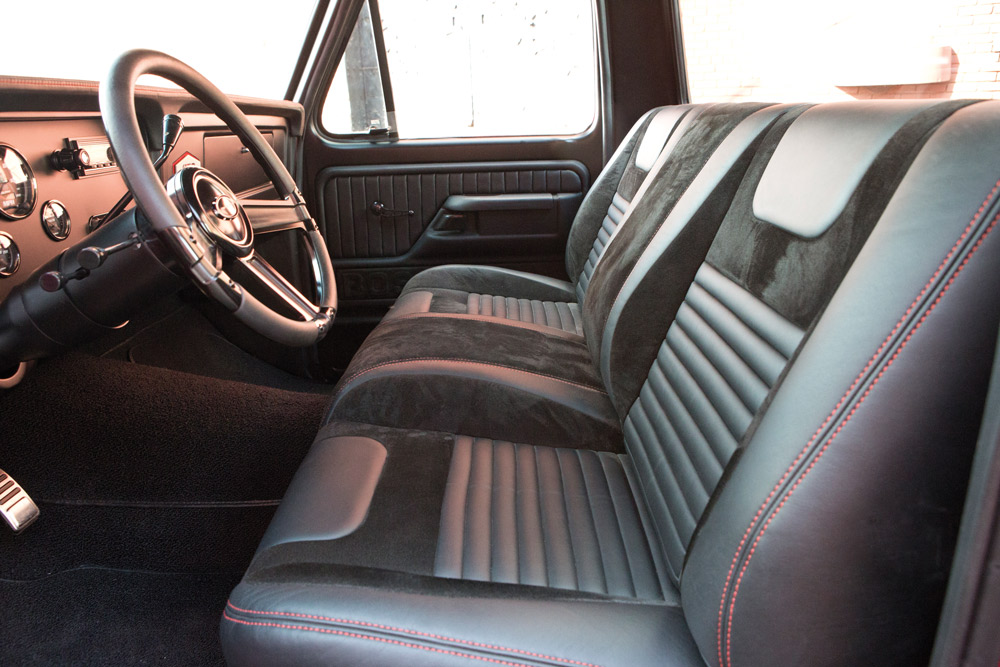
After coordinating with Travis Highlander of Highlander Concept Rendering, Jason had a good visual of what the truck could look like. From there Ross Tyler of ART Photography helped him put together a proposal, and then he contacted several companies to find a way to get the truck displayed on the indoor show floor at SEMA. This was a scary moment because he’d started tearing into the truck and was still unsure if it would be accepted into the show. Soon after, he received an email from the team at Vortech Superchargers, and they started conversations about the project. Vortech decided they were in and now it was time to find a shop to help make it happen.
“IT WAS A MAD RUSH TO FINISH THE TRUCK IN TIME FOR SEMA 2014. I REMEMBER GETTING UPDATES ON THE BUILD A WEEK BEFORE THE SHOW, AND IT WAS STILL IN PIECES ON THE EAST COAST.”
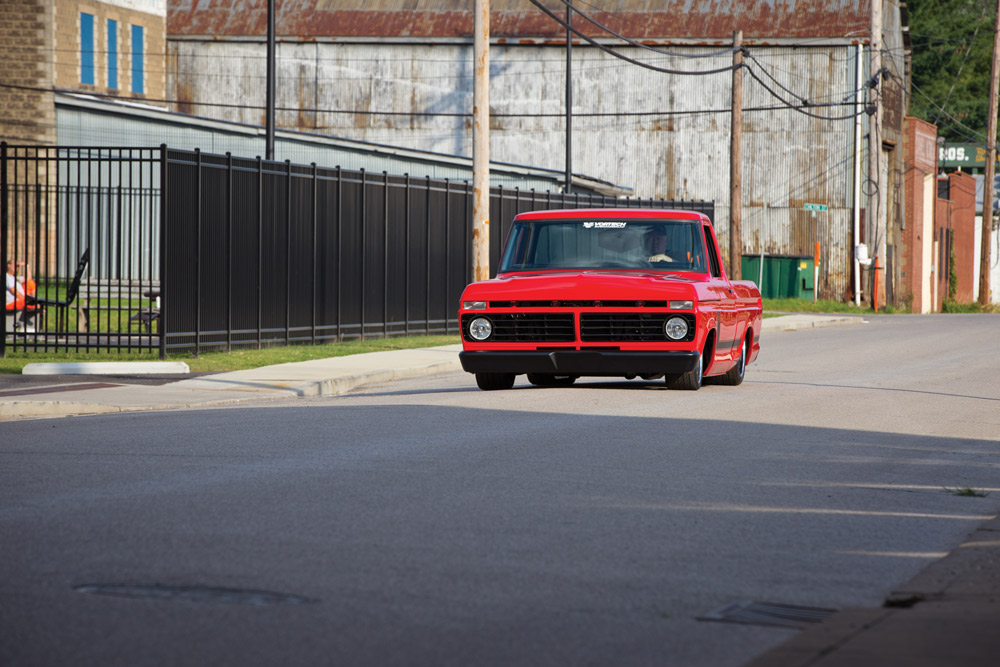

Jason had everything lined up, or at least he thought he did, and the plan was to drop in a Coyote engine and plant the truck on the floor. After a few months, Jason was struck with some bad news. The shop that had taken on the build was unable to make the bolt-on front suspension work with power steering. The aftermarket front cross member also placed the engine so high that a Boss 302 intake and Vortech Supercharger couldn’t fit under the hood. On top of that, the shop was inundated with other projects, and it didn’t look like the crew would be able to finish Jason’s truck in time.

With the truck blown apart, Jason had to pick up the pieces and move on. The F-100 was taken to Hart Fab where Josh Hart, John Ortiz and Brian Ortiz were willing to take on the huge build in a short amount of time. The first thing on the list was to reconfigure the front suspension. A call was made to Scott’s Hotrods ‘N Customs to order a Super Slam IFS system, not only to add airbags but also so they could use a rack-and-pinion power steering setup to turn the massive 22×9-inch B Forged 595 front wheels. Then Josh added custom metal work in the bed and the engine bay. He also had Bobby Martins of Sadistic Iron Werks stamp “Boss” into a piece of sheet metal that was later grafted into the tailgate. From there Jeff Volker of Volkers Autobody was enlisted to handle the paint and body. On the inside, Scott Zielinski of Sew it Seams Custom Automotive Interiors handled all of the upholstery.

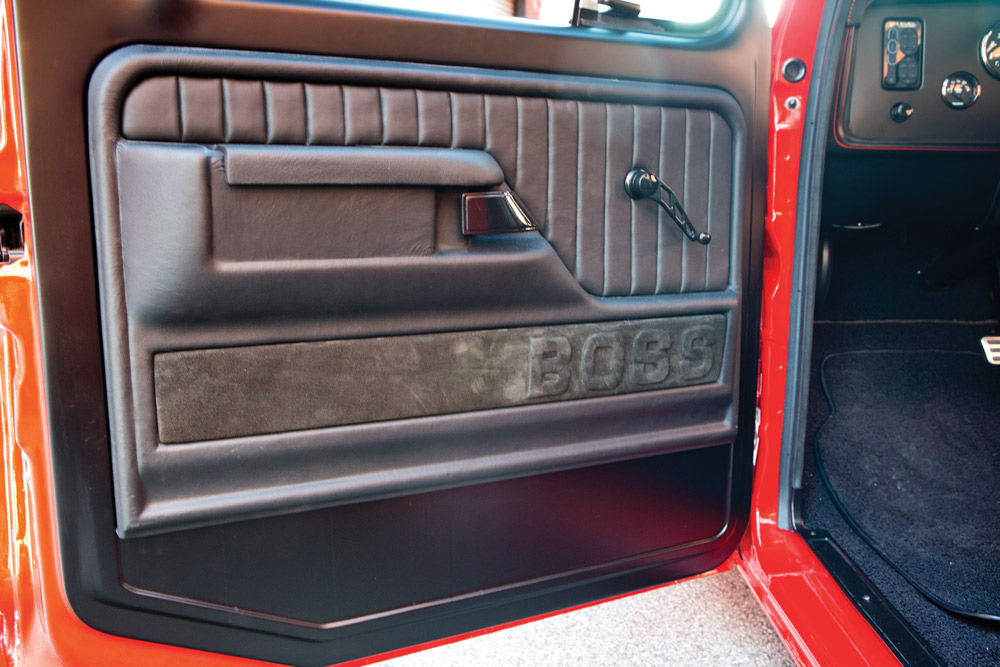
It was a mad rush to finish the truck in time for SEMA 2014. I remember getting updates on the build a week before the show, and it was still in pieces on the East Coast, which is pretty far from the Las Vegas Convention Center. Jason says they were so busy and sleep deprived that “the guys were all like walking zombies those last four, five weeks.” The truck was so rushed together that when Josh and John transported it across the country, the paint was still wet. It was so soft that Jeremy Seanor of Lucky Strike couldn’t paint the Boss stripes on the sides.
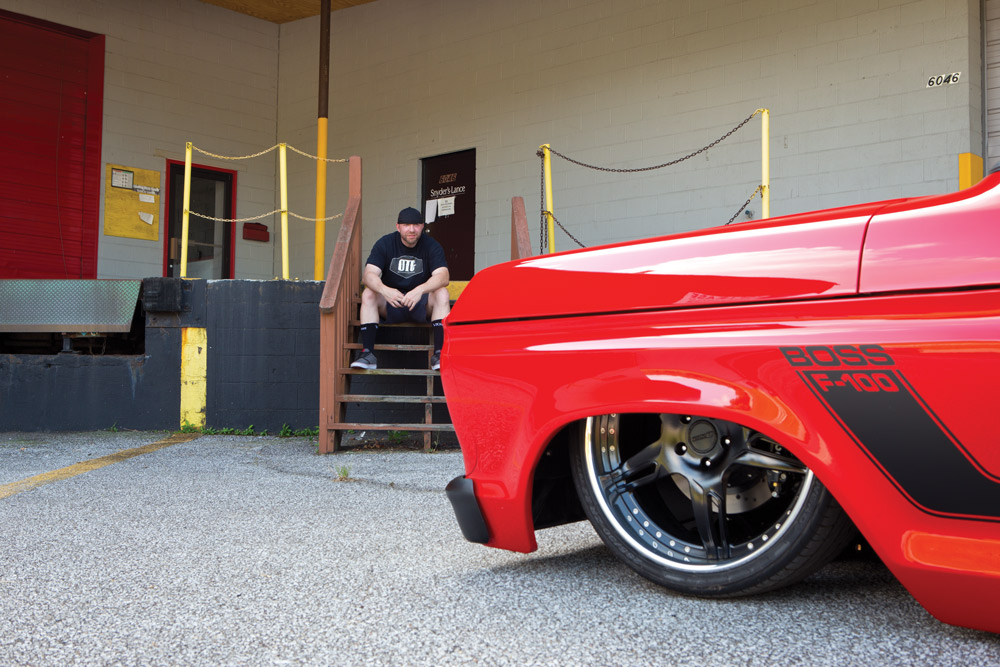
Though it was complete madness to get this truck ready for SEMA, it all paid off. The truck was rolled into the Vortech booth in the center hall. Laid out and in bright red paint with a supercharged Coyote engine. It grabbed everyone’s attention. It was certainly one of the most memorable trucks in attendance, and it shined a new light on Dentside F-100s. Hopefully this truck paves the way for others because it sure does look mean with all of its upgrades.
[divider]TRUCK SPECS[/divider]
OWNER
Jason Jones
1973 Ford Dentside F-100
Dallas, TX
ENGINE
SUSPENSION
WHEELS & TIRES
BODY & PAINT
INTERIOR/STEREO
SPECIAL THANKS FROM THE OWNER: “Special thanks to God, my wife Autumn, brother Sean and Kenneth Gamble, as well as the amazing team of craftsmen that busted their ass on the build. Josh Hart, Jeff Volker, Scott Zielinski and the entire Cline and Thompson families, just to name a few. Also huge thanks to AccuAir and Vortech for getting us to SEMA and taking a chance on us.”
Why are dentside F-100s popular among restoration enthusiasts?
Restoration enthusiasts have a special affinity for the sixth-generation “dentside” F-100s. Here’s why:
With production numbers ranging between 200,000 to 400,000 units annually, these trucks are relatively easy to find. This makes the initial step of acquiring a dentside F-100 far less daunting compared to rarer models.
The high production volume of these trucks means that quality parts for restoration are readily available. Whether you’re shopping for OEM parts, aftermarket upgrades, or need specific vintage components, you’re likely to find what you need without extensive searching.
Dentside F-100s boast a timeless, classic design that appeals to many restoration enthusiasts. The sleek lines, iconic grill, and robust build offer a nostalgic trip back to the ’70s, making them an ideal canvas for those looking to preserve or enhance this historical vehicle.
The popularity of dentside F-100s has led to the development of a strong community of enthusiasts and experts. This makes it easier to find advice, detailed restoration guides, and community support, which is invaluable for both novice and experienced restorers.
A well-restored dentside F-100 can fetch a significant price on the classic car market. Many enthusiasts see these restorations not just as a hobby but as a sound investment, anticipating their value to grow over time.
In summary, the ease of finding both the trucks and their parts, combined with their aesthetic appeal and strong community support, makes the dentside F-100s a go-to choice for restoration projects.
What functional changes were made to the dentside F-100 compared to previous generations?
In 1973, the newly introduced sixth generation of a popular pickup truck, often referred to as the “dentside,” brought several functional enhancements compared to its predecessors. These changes weren’t immediately apparent from the exterior; instead, they focused on improving the truck’s performance, safety, and durability.
Instead of overhauling the design, the focus was on retaining the proven chassis while making meaningful improvements under the hood and within the cab. Despite the “dentside” and its predecessor, the “bumpside,” sharing a similar outwardly sleek and modern design, the functional upgrades of the “dentside” truly set it apart.
By emphasizing practical enhancements such as safety, durability, and engine performance, the “dentside” aimed to provide a better driving experience without compromising the classic aesthetic appeal that enthusiasts loved.
What are the strengths and weaknesses of the bumpside and dentside F-100 models?
When choosing between bumpside and dentside F-100s, it’s essential to weigh the unique strengths and weaknesses of each model. Both have distinct characteristics that appeal to different enthusiasts.
Strengths:
Weaknesses:
Strengths:
Weaknesses:
In conclusion, choosing between a bumpside or dentside F-100 ultimately depends on individual preferences and priorities. Whether you favor the vintage allure and bold look of the bumpside or the refined lines and modern advancements of the dentside, both models remain iconic and beloved by truck enthusiasts.
What are the key differences between the bumpside and dentside F-100 trucks?
When comparing the “bumpside” and “dentside” generations of F-100 trucks, several key differences come to light, despite their visual similarities.
One primary difference lies in their approach to corrosion resistance. The “bumpside” trucks often suffered from corrosion issues. To combat this, “dentside” models incorporated corrosion-resistant materials in their sheet metal. This improvement significantly boosted the longevity and durability of the later trucks.
Engine technology also saw noteworthy advancements between these generations. The “dentside” trucks benefitted from the introduction of the Cleveland V8 engine, resulting in substantial gains in horsepower and torque. These enhancements offered a marked improvement in performance compared to the earlier “bumpside” models.
Safety innovations were another area where the “dentside” trucks excelled. A significant change was the relocation of the gas tank. In “bumpside” models, the gas tank was positioned behind the seat in the cab, posing a danger during accidents. In “dentside” models, the tank was moved to a safer location between the frame rails under the bed. Additionally, “dentside” trucks were the first F-100s to feature disc brakes, providing better stopping power and reliability.
To summarize:
These advancements marked significant progress in both the durability and safety of the F-100 series, elevating the “dentside” generation above its predecessor.
What safety features were introduced in the dentside F-100?
The Dentside F-100 saw several advancements in safety aimed at protecting drivers and passengers. One of the most significant changes was relocating the gas tank from its previous position behind the cab seat to a safer location between the frame rails under the bed. This adjustment reduced the risk of fuel-related injuries in the event of an accident.
Another important safety upgrade was the inclusion of disc brakes. For the first time, this generation of trucks came equipped with disc brakes, which offered superior stopping power and increased reliability compared to the drum brakes used in previous models. These improvements collectively contributed to a much safer driving experience.
How did Ford address corrosion issues in the dentside F-100 compared to the bumpside?
The earlier F-100 models, known for their distinctive “bumpside” design, often struggled with corrosion—a common issue that compromised the vehicle’s durability. Learning from this, Ford made significant improvements in their subsequent “dentside” F-100 models.
To combat the persistent rust problems, Ford incorporated corrosion-resistant materials into the dentside models. They enhanced the sheet metal with specific treatments aimed at prolonging the structure’s lifespan.
These advancements not only improved the exterior aesthetics but also ensured the internal frame remained robust over time. By fortifying the sheet metal, Ford effectively mitigated the earlier corrosion issues, making the dentside models more reliable and enduring.
In essence, through strategic use of better materials and enhanced treatment processes, Ford tackled the corrosion challenges head-on, substantially boosting the longevity of the dentside F-100.
What are some similarities between the bumpside and dentside F-100 trucks?
When comparing the bumpside and dentside F-100 trucks, several notable similarities stand out, which have made these models favorites among both work truck buyers and hot rod enthusiasts.
Both the bumpside and dentside F-100s offered a versatile range of engines and configurations. This variety allowed consumers to tailor the vehicle to their specific needs, whether they required a robust engine for heavy-duty tasks or a more modest configuration for everyday use.
At the heart of both the bumpside and dentside generations is a strikingly similar chassis. Recognizing the popularity of the fifth-generation aesthetic, designers opted to maintain much of its look for the subsequent generation. This decision helped preserve a unique style that stood apart in the market.
One of the key reasons enthusiasts have embraced terms like “bumpside” and “dentside” is the striking outward similarity between the two generations. Both feature a prominent line running down the side of the frame, either as a bump or a dent, which quickly identifies the model at a glance. This distinctive styling element has made the terms convenient shorthand for distinguishing the fifth and sixth generations.
Both generations enjoyed popularity among similar buyer groups. Work truck users appreciated their durability and versatility, while hot rod enthusiasts were drawn to their customizable nature and sleek design.
By examining these similarities, it’s clear why the bumpside and dentside F-100 trucks have maintained their icon status among vehicle enthusiasts.
What years were the dentside Ford F-100 produced?
The term “dentside” refers to the sixth generation of a popular pickup truck, specifically produced between 1973 and 1979.
Why might someone choose a bumpside F-100 over a dentside F-100, or vice versa?
Why Choose a Bumpside F-100 Over a Dentside, or Vice Versa?
Muscular Appearance: One of the primary reasons enthusiasts lean towards the bumpside F-100 is its striking design. The defined body lines and bolder contours give it a classic, rugged look that stands out, especially among vintage truck collectors.
Vintage Appeal: For those captivated by nostalgia, the bumpside models, produced from 1967 to 1972, represent an era of automotive history that exudes character and charm. Their vintage stylings often make them a favorite at car shows and among restoration aficionados.
Smoother Body Lines: Introduced in 1973 and running until 1979, the dentside F-100 features more streamlined bodywork. Its design provides a more refined and contemporary appearance compared to the bumpside, appealing to those who prefer a subtler aesthetic.
Advanced Specifications: The dentside models benefit from improvements in automotive engineering and safety standards of the era. Notably, the introduction of the powerful 460 V8 engine, coupled with enhanced production materials, makes the dentside a robust choice for truck enthusiasts looking for performance and durability.
Both bumpside and dentside F-100s are excellent candidates for restoration projects:
Choosing between a bumpside and a dentside F-100 ultimately depends on your personal preferences and goals for your vehicle. If you’re drawn to a more muscular, vintage look, the bumpside may be your ideal match. On the other hand, if you appreciate smoother lines and advanced specifications, the dentside could be the better fit. Either way, both models hold a cherished place in the hearts of truck enthusiasts and offer rich opportunities for restoration.
Which is considered better: the bumpside or the dentside Ford F-100?
Choosing between the bumpside and dentside Ford F-100 models boils down to personal preference. Each model has distinct attributes that appeal to different enthusiasts for various reasons.
Ultimately, whether the bumpside or dentside Ford F-100 is better is subjective and hinges on what factors you value most highly. Both models have earned their place in automotive history and continue to captivate the imaginations of truck enthusiasts nationwide.
What trim levels were available for the bumpside F-100?
The Bumpside F-100, produced between 1967 and 1972, came in three distinct trim levels, each catering to different customer needs and preferences:
Throughout its production years, the specific features and slight variations within each trim level evolved, yet the core options remained consistent. The introduction of these trims marked a significant shift towards offering more personalized and comfortable driving experiences straight from the factory.
What do the terms “bumpside” and “dentside” mean in relation to the Ford F-100?
“Bumpside” and “dentside” are terms coined by truck aficionados to describe particular generations of the Ford F-100, specifically from the 1960s and 1970s.
The “bumpside” term refers to the fifth generation of the F-100, manufactured between 1967 and 1972. This moniker originates from the distinctive design feature of this era: prominent ridges or “bumps” along the sides of the truck. These reinforcement ribs were initially added to strengthen the body panels but ended up giving the vehicle a recognizable appearance.
On the other hand, “dentside” is a term used to describe the sixth generation of the F-100, which was produced from 1973 to 1979. During these years, the trucks showcased a smoother, more rounded look with a long, narrow indentation running along the body’s side panels. This design change aimed to modernize the truck, and the distinctive indent earned it the nickname “dentside.”
In summary, “bumpside” and “dentside” help enthusiasts and collectors quickly differentiate between the unique body styles of the F-100 produced during these two pivotal periods.
How did Ford’s marketing strategy change with the introduction of the bumpside F-100?
With the introduction of the bumpside F-100, Ford’s marketing strategy took a notable turn. Gone were the days when the F-100 was pitched solely as a rugged workhorse. The new approach aimed to broaden the truck’s appeal, targeting not just professionals but everyday drivers.
Ford significantly highlighted interior comfort and features, recognizing that potential buyers were no longer just interested in raw power and utility. They sought a vehicle that could serve dual purposes: robust enough for work and comfortable enough for daily commutes.
By incorporating a more refined interior, enhanced seating, and convenient features, Ford positioned the F-100 as a versatile option for families and individuals alike. The goal was to turn heads not only with its capabilities but also its comfort and style.
Campaigns showcased the F-100’s strength without sacrificing comfort, creating a balanced image of a truck that was both tough and inviting. This shift was instrumental in transforming public perception, making the bumpside F-100 a compelling choice for a wider range of consumers.
In summary, Ford’s revamped marketing strategy for the bumpside F-100 focused on versatility, targeting a broader audience by emphasizing comfort and dual-purpose functionality.
Share Link